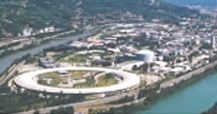
The emission of synchrotron radiation requires an accelerator capable of creating an electron beam and accelerating the electrons close to the speed of light (an insertion accelerator) as well as an accelerator (a storage ring) that maintains the electron beam in a circular orbit.
Third-generation facilities are optimized to use insertion devices, mainly undulators. A large-scale synchrotron radiation facility is generally defined as a facility that has electron energy of more than 5 GeV, and is capable of delivering X-rays from undulators. There are three third-generation large-scale synchrotron radiation facilities in the world today: SPring-8, ESRF and APS.
First-generation facilities were not built specially to generate synchrotron radiation, but were intended for research in particle physics, and second-generation facilities were built specifically for synchrotron radiation but principally used bending magnets.

APS


| Names of the Facilities |
ESRF European Synchrotron Radiation Facility |
APS Advanced Photon Source |
SPring-8 |
|---|---|---|---|
| Constructed by | 16 European Countries | US Department of Energy | JAERI & RIKEN |
| Operated by | ESRF | ANL | JASRI |
| Location | Grenoble, France | Argonne, US | Harima Science Garden City, Japan |
| Electron Energy | 6 GeV | 7 GeV | 8 GeV |
| Number of Beamlines | 56 | 68 | 62 |
| Storage Ring Circumference | 844 m | 1104 m | 1436 m |
| Planning | 1986 - 1987 | 1986 - 1988 | 1987 - 1989 |
| Construction | 1988 - 1994 | 1989 - 1994 | 1991 - 1997 |
| Operation | 1994 - | 1996 - | 1997 - |







